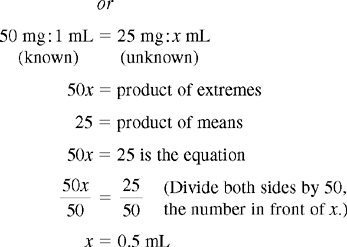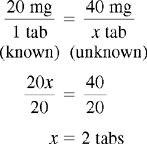CHAPTER 14 After reviewing this chapter, you should be able to: 1. State a ratio and proportion to solve a given dosage calculation problem 2. Solve simple calculation problems using the ratio and proportion method Several methods are used for calculating dosages. The most common methods are ratio and proportion and use of a formula. After presentation of the various methods, students can choose the method they find easiest and most logical to use. First, let’s discuss calculating by using ratio and proportion. If necessary, review Chapter 4 on ratio and proportion. Order: 1 g p.o. of an antibiotic Available: 500 mg capsules. How many capsules will you administer?
Dosage Calculation Using the Ratio and Proportion Method
USE OF RATIO AND PROPORTION IN DOSAGE CALCULATION
Example 3:













